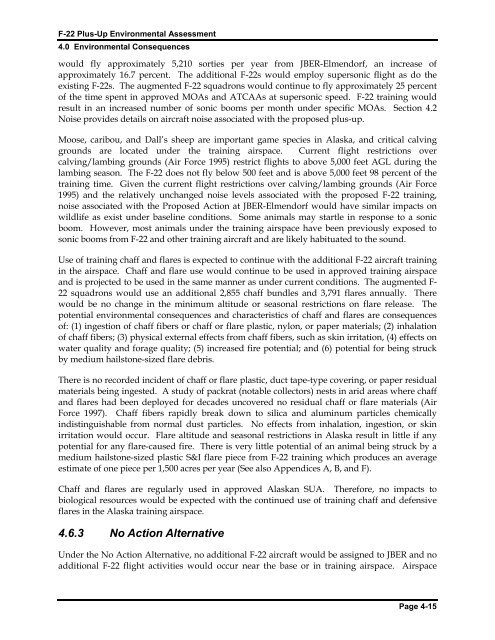F-22 Plus-Up Environmental Assessment - Joint Base Elmendorf ...
F-22 Plus-Up Environmental Assessment - Joint Base Elmendorf ...
F-22 Plus-Up Environmental Assessment - Joint Base Elmendorf ...
You also want an ePaper? Increase the reach of your titles
YUMPU automatically turns print PDFs into web optimized ePapers that Google loves.
F-<strong>22</strong> <strong>Plus</strong>-<strong>Up</strong> <strong>Environmental</strong> <strong>Assessment</strong><br />
4.0 <strong>Environmental</strong> Consequences<br />
would fly approximately 5,210 sorties per year from JBER-<strong>Elmendorf</strong>, an increase of<br />
approximately 16.7 percent. The additional F-<strong>22</strong>s would employ supersonic flight as do the<br />
existing F-<strong>22</strong>s. The augmented F-<strong>22</strong> squadrons would continue to fly approximately 25 percent<br />
of the time spent in approved MOAs and ATCAAs at supersonic speed. F-<strong>22</strong> training would<br />
result in an increased number of sonic booms per month under specific MOAs. Section 4.2<br />
Noise provides details on aircraft noise associated with the proposed plus-up.<br />
Moose, caribou, and Dall’s sheep are important game species in Alaska, and critical calving<br />
grounds are located under the training airspace. Current flight restrictions over<br />
calving/lambing grounds (Air Force 1995) restrict flights to above 5,000 feet AGL during the<br />
lambing season. The F-<strong>22</strong> does not fly below 500 feet and is above 5,000 feet 98 percent of the<br />
training time. Given the current flight restrictions over calving/lambing grounds (Air Force<br />
1995) and the relatively unchanged noise levels associated with the proposed F-<strong>22</strong> training,<br />
noise associated with the Proposed Action at JBER-<strong>Elmendorf</strong> would have similar impacts on<br />
wildlife as exist under baseline conditions. Some animals may startle in response to a sonic<br />
boom. However, most animals under the training airspace have been previously exposed to<br />
sonic booms from F-<strong>22</strong> and other training aircraft and are likely habituated to the sound.<br />
Use of training chaff and flares is expected to continue with the additional F-<strong>22</strong> aircraft training<br />
in the airspace. Chaff and flare use would continue to be used in approved training airspace<br />
and is projected to be used in the same manner as under current conditions. The augmented F-<br />
<strong>22</strong> squadrons would use an additional 2,855 chaff bundles and 3,791 flares annually. There<br />
would be no change in the minimum altitude or seasonal restrictions on flare release. The<br />
potential environmental consequences and characteristics of chaff and flares are consequences<br />
of: (1) ingestion of chaff fibers or chaff or flare plastic, nylon, or paper materials; (2) inhalation<br />
of chaff fibers; (3) physical external effects from chaff fibers, such as skin irritation, (4) effects on<br />
water quality and forage quality; (5) increased fire potential; and (6) potential for being struck<br />
by medium hailstone-sized flare debris.<br />
There is no recorded incident of chaff or flare plastic, duct tape-type covering, or paper residual<br />
materials being ingested. A study of packrat (notable collectors) nests in arid areas where chaff<br />
and flares had been deployed for decades uncovered no residual chaff or flare materials (Air<br />
Force 1997). Chaff fibers rapidly break down to silica and aluminum particles chemically<br />
indistinguishable from normal dust particles. No effects from inhalation, ingestion, or skin<br />
irritation would occur. Flare altitude and seasonal restrictions in Alaska result in little if any<br />
potential for any flare-caused fire. There is very little potential of an animal being struck by a<br />
medium hailstone-sized plastic S&I flare piece from F-<strong>22</strong> training which produces an average<br />
estimate of one piece per 1,500 acres per year (See also Appendices A, B, and F).<br />
Chaff and flares are regularly used in approved Alaskan SUA. Therefore, no impacts to<br />
biological resources would be expected with the continued use of training chaff and defensive<br />
flares in the Alaska training airspace.<br />
4.6.3 No Action Alternative<br />
Under the No Action Alternative, no additional F-<strong>22</strong> aircraft would be assigned to JBER and no<br />
additional F-<strong>22</strong> flight activities would occur near the base or in training airspace. Airspace<br />
Page 4-15
















